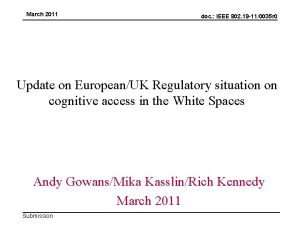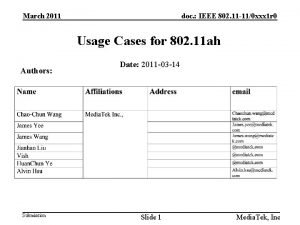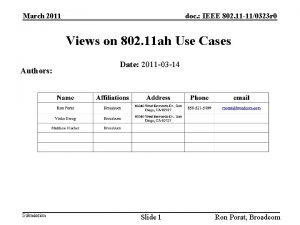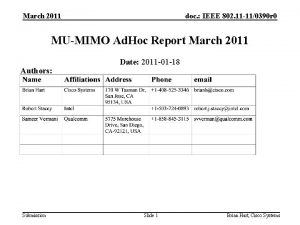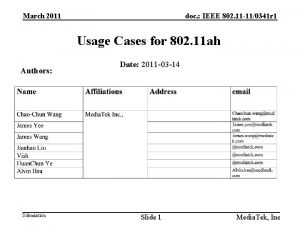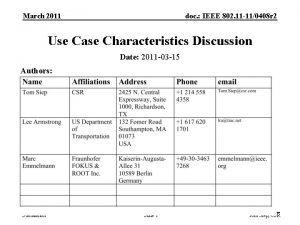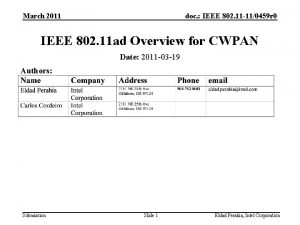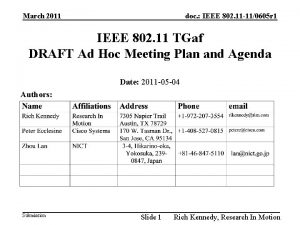March 2011 doc IEEE 802 11 110313 r











- Slides: 11

March 2011 doc. : IEEE 802. 11 -11/0313 r 1 SU-MIMO Type for Group Addressed Frames Authors: Submission Date: 2011 -03 -14 1 Jarkko Kneckt, Nokia

March 2011 doc. : IEEE 802. 11 -11/0313 r 1 Abstract The presentation describes means to detect: • The BSSID (TA) of the BSS that transmitted the group addressed frame • The group address (RA) of the transmitted frame The BSSID and group address detection from the VHT-SIG A enables group addressed receivers to skip the reception of unnecessary group addressed frames and to improve the non-AP STA power efficiency especially in the stand-by mode and in passive scanning. The presentation and normative text in 11 -11 -314 r 1 provide solution for CIDs: 124, 665, 666, 667, 669, 973 and 1341. Submission 2 Jarkko Kneckt, Nokia

March 2011 doc. : IEEE 802. 11 -11/0313 r 1 Recap, Address Indication in PLCP Header • 802. 11 ac is introducing new PLCP header format – The PLCP header indicates the recipient(s) and transmitter of the PPDU • Currently the PLCP header indicates: – Individually addressed PPDU to single user (SU) • The AID defines the recipient – Individually addressed aggregated PPDU (A-PPDU) to multiple users (MU) • The Group ID defines the recipients – Group addressed PPDU • The AID set to 0 indicates group address Submission 3 Jarkko Kneckt, Nokia

March 2011 doc. : IEEE 802. 11 -11/0313 r 1 Challenges of the Address Indication in PLCP Header • Currently PLCP header has partial AID set to 0 for group addressed frames. There is no means to detect: – Transmitter Address (BSSID) – Receiver Address (group address) • The current format forces STAs to receive all group addressed PPDUs – Device cannot filter frames from other BSSIDs – Devices cannot filter frames from unnecessary group addresses that it is receiving Submission 4 Jarkko Kneckt, Nokia

March 2011 doc. : IEEE 802. 11 -11/0313 r 1 Solution, VHT-SIG A field of the PLCP header • Currently VHT-SIG A field is capable to indicate: – 63 MU – MIMO groups – 1 SU – MIMO transmission type • VHT-SIG A field will be capable to indicate: – 62 MU – MIMO groups – 2 SU – MIMO transmission types • Bit 9 set to 1 for individually addressed PPDU, Partial AID in Nsts field • Bit 9 set to 0 for group addressed PPDU , Group Address Indication in Nsts field Submission 5 Jarkko Kneckt, Nokia

March 2011 doc. : IEEE 802. 11 -11/0313 r 1 Solution, Group Address Indication • Introduce GROUP_ADDR_IND: – TXVECTOR GROUP_ADDR_IND[0: 3] = BSSID[0: 3] XOR BSSID[4: 7] • Identification of transmitter address (TA) – TXVECTOR GROUP_ADDR_IND[4: 7]= Group Address [0: 3] • Identification of receiver address (RA) – TXVECTOR GROUP_ADDR_IND[8] = More Data bit • Are more group addressed frames transmitted by the transmitter • Details of the scheme are described in 11 -11 -XXXX-0000 ac-Indication-of-Group-Address. doc Submission 6 Jarkko Kneckt, Nokia

March 2011 doc. : IEEE 802. 11 -11/0313 r 1 Stand-by Power Consumption • In the stand-by the devices receive and transmit very little individually addressed frames • The group addressed data generation may be the only received frames in the stand-by – The device cannot control the amount of group addressed frames: • Other BSSs may distribute a lot of group addressed frames • A STA in BSS may generate and request a lot of group addressed frames transmission • The reception of unnecessary group addressed frames increases the stand-by power consumption – The stand-by power consumption defines the battery life time Submission 7 Jarkko Kneckt, Nokia

March 2011 doc. : IEEE 802. 11 -11/0313 r 1 Filtering of Frames • STAs may stop reception of individually addressed frames to PLCP header – The header contains indication of the transmitter and receiver addresses • The current 802. 11 ac PLCP header has no means to specify the group address or transmitter of the PPDU – The transmitter and group address are present in MAC header forcing to receive the whole MPDU • FCS at the end of MPDU ensures the correctness of the frame • The PLCP header filtering should be used for both the individually and group addressed frames – The same operation simplify the implementation PLCP Synch + Header MAC Header Submission 8 Data Payload FCS Jarkko Kneckt, Nokia

March 2011 doc. : IEEE 802. 11 -11/0313 r 1 Comparing the filtering efficiency Group addressed PPDU TXOP obtaining Beacon TXOP obtaining Operation flow: Group addressed PPDU Time The SU-MIMO type for group addressed frames enable big increase to sleep durations. Submission 9 Jarkko Kneckt, Nokia

March 2011 doc. : IEEE 802. 11 -11/0313 r 1 Summary • The improved group addressed PPDUs handling enables: – Better addressing of the transmitted PPDUs • More reliability and better understanding of the transmitted traffic – Lower power consumption: • The identifier for the transmitter of the group addressed frame enables filtering group addressed frames to other BSSs • The identifier of group address enables to decide which frames to receive • Especially the stand-by power consumption is reduced Submission 10 Jarkko Kneckt, Nokia

March 2011 doc. : IEEE 802. 11 -11/0313 r 1 Pre-motion • Do you accept to include the normative text as described in 11 -11 -0314 -00 -00 ac-SU-MIMO-type-forgroup-addressed-frames-text. doc to the spec framework document? • Y • N • A Submission 11 Jarkko Kneckt, Nokia













